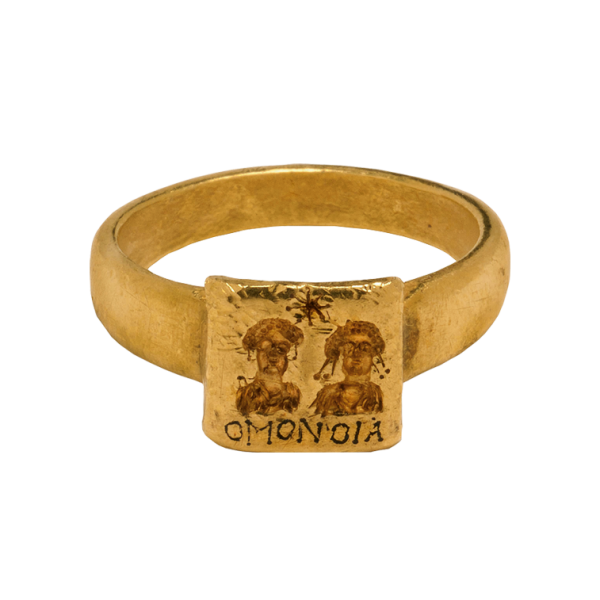Information about rings in late Antiquity comes from Roman authors, such as Pliny, Martial, and Clement of Alexandria. In his Natural History Pliny states: “... many people do not allow any gems in a signet-ring, and seal with the gold itself; this was a fashion invented when Claudius Caesar was Emperor.” The Roman poet Martial remarked in the first century A.D. he had seen a middle-class citizen wearing no less than six rings on each finger; although under Septimus Severus (died 211 A.D.) a decree was issued allowing each soldier to wear a single gold ring. The Church Fathers, such as Clement of Alexandria, discouraged wearing any jewelry at all. However, they did permit Christians to wear one ring, either the seal of their family or the wedding ring; and rings bearing Christian symbols such as fish, birds, and inscriptions of religious character were deemed acceptable.
The types of rings from this period include examples with nominative inscriptions or plain gold monograms for sealing, marriage and betrothal rings, devotional and religious rings, and decorative rings. Some marriage and fidelity rings are expressly related to the formal institution of marriage and its vows. The symbolic linking of the couple that is expressed in the dextrarum junctio, or the joining of hands, persisted from ceremonies from Roman times. One type of marriage ring thus displays two joined hands. Portraits of the bride and groom, sometimes with crowns over their heads (actually used in ceremonies) or a cross between them, also exist in rings. The man is typically portrayed on the left, in the position of greater importance. Such rings suggest that men and women shared an emotional bond and a practical partnership. Other strictly Byzantine examples depict the bride and groom flanking Christ to indicate that he officiates over the union of bride and groom, sealed by his cross. Typical inscriptions include OMONOIA (Concord) and XAPIC (Grace). In the seventh century, Isidore of Seville wrote: “The ring is given by the espouser to the espoused either as a sign of mutual fidelity ... therefore the ring is placed on the fourth finger because a certain vein, it is said, flows thence to the heart.”
Other types of rings of the period include decorative rings with attractive gemstones, cameos, and intaglios, sometimes set in beautifully wrought bands made with pierced, twisted, and beaded gold. The excesses associated with the later Roman Empire find expression in two-, three-, and four-finger rings, many made in Alexandria, and in the proliferation of baby rings perhaps not only intended for infants and small children but also meant to adorn statuary as votive offerings. In the Byzantine East, devotional rings like small icons depict frontal standing figures of saints, God the Father, or the Virgin Mary. The love of bright, gleaming colors, so evident in Byzantine mosaics, metalwork, and manuscript illumination, has its counterpart in richly enameled rings.
